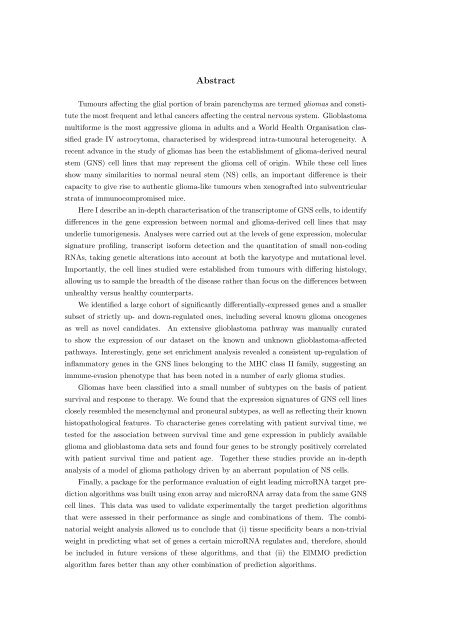Transcriptional Characterization of Glioma Neural Stem Cells Diva ...
Transcriptional Characterization of Glioma Neural Stem Cells Diva ...
Transcriptional Characterization of Glioma Neural Stem Cells Diva ...
You also want an ePaper? Increase the reach of your titles
YUMPU automatically turns print PDFs into web optimized ePapers that Google loves.
Abstract<br />
Tumours affecting the glial portion <strong>of</strong> brain parenchyma are termed gliomas and consti-<br />
tute the most frequent and lethal cancers affecting the central nervous system. Glioblastoma<br />
multiforme is the most aggressive glioma in adults and a World Health Organisation clas-<br />
sified grade IV astrocytoma, characterised by widespread intra-tumoural heterogeneity. A<br />
recent advance in the study <strong>of</strong> gliomas has been the establishment <strong>of</strong> glioma-derived neural<br />
stem (GNS) cell lines that may represent the glioma cell <strong>of</strong> origin. While these cell lines<br />
show many similarities to normal neural stem (NS) cells, an important difference is their<br />
capacity to give rise to authentic glioma-like tumours when xenografted into subventricular<br />
strata <strong>of</strong> immunocompromised mice.<br />
Here I describe an in-depth characterisation <strong>of</strong> the transcriptome <strong>of</strong> GNS cells, to identify<br />
differences in the gene expression between normal and glioma-derived cell lines that may<br />
underlie tumorigenesis. Analyses were carried out at the levels <strong>of</strong> gene expression, molecular<br />
signature pr<strong>of</strong>iling, transcript is<strong>of</strong>orm detection and the quantitation <strong>of</strong> small non-coding<br />
RNAs, taking genetic alterations into account at both the karyotype and mutational level.<br />
Importantly, the cell lines studied were established from tumours with differing histology,<br />
allowing us to sample the breadth <strong>of</strong> the disease rather than focus on the differences between<br />
unhealthy versus healthy counterparts.<br />
We identified a large cohort <strong>of</strong> significantly differentially-expressed genes and a smaller<br />
subset <strong>of</strong> strictly up- and down-regulated ones, including several known glioma oncogenes<br />
as well as novel candidates. An extensive glioblastoma pathway was manually curated<br />
to show the expression <strong>of</strong> our dataset on the known and unknown glioblastoma-affected<br />
pathways. Interestingly, gene set enrichment analysis revealed a consistent up-regulation <strong>of</strong><br />
inflammatory genes in the GNS lines belonging to the MHC class II family, suggesting an<br />
immune-evasion phenotype that has been noted in a number <strong>of</strong> early glioma studies.<br />
<strong>Glioma</strong>s have been classified into a small number <strong>of</strong> subtypes on the basis <strong>of</strong> patient<br />
survival and response to therapy. We found that the expression signatures <strong>of</strong> GNS cell lines<br />
closely resembled the mesenchymal and proneural subtypes, as well as reflecting their known<br />
histopathological features. To characterise genes correlating with patient survival time, we<br />
tested for the association between survival time and gene expression in publicly available<br />
glioma and glioblastoma data sets and found four genes to be strongly positively correlated<br />
with patient survival time and patient age. Together these studies provide an in-depth<br />
analysis <strong>of</strong> a model <strong>of</strong> glioma pathology driven by an aberrant population <strong>of</strong> NS cells.<br />
Finally, a package for the performance evaluation <strong>of</strong> eight leading microRNA target pre-<br />
diction algorithms was built using exon array and microRNA array data from the same GNS<br />
cell lines. This data was used to validate experimentally the target prediction algorithms<br />
that were assessed in their performance as single and combinations <strong>of</strong> them. The combi-<br />
natorial weight analysis allowed us to conclude that (i) tissue specificity bears a non-trivial<br />
weight in predicting what set <strong>of</strong> genes a certain microRNA regulates and, therefore, should<br />
be included in future versions <strong>of</strong> these algorithms, and that (ii) the ElMMO prediction<br />
algorithm fares better than any other combination <strong>of</strong> prediction algorithms.

















